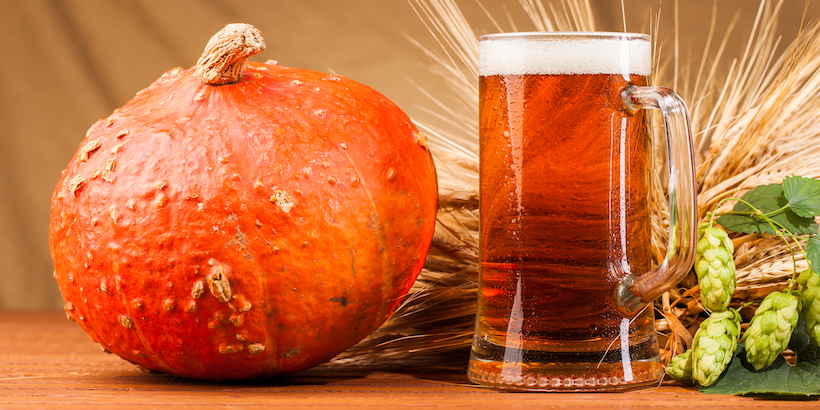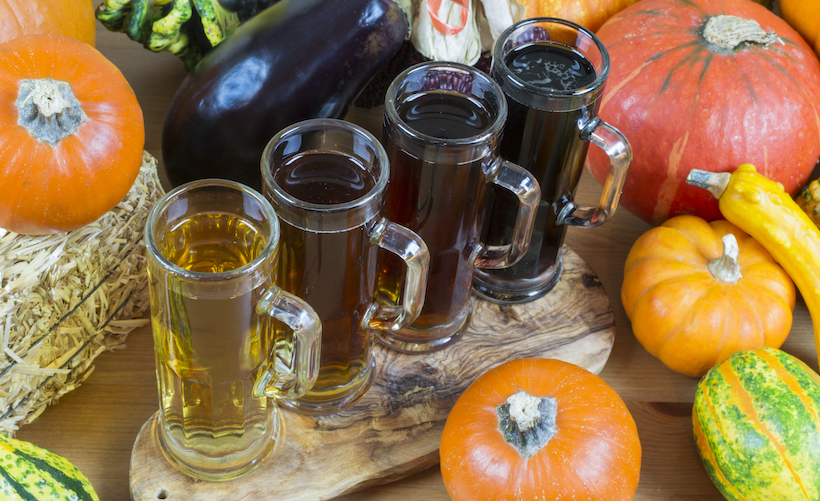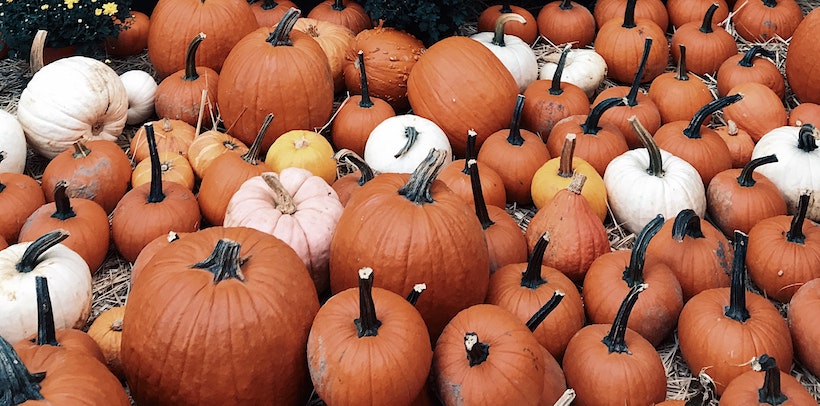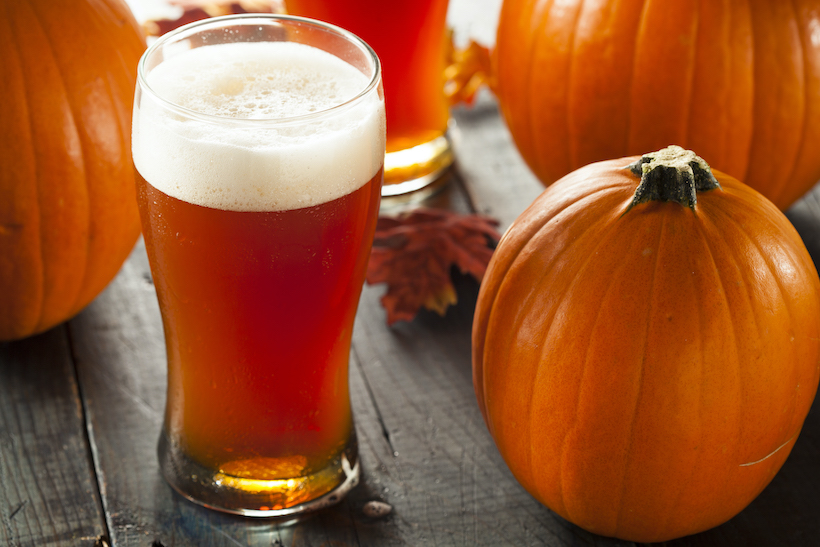Pumpkin beer is one of my favorite – if controversial – tastes every fall. And for me, autumn doesn't really begin until I see pumpkin beer on the shelves.
But apart from being a fall staple, did you know that pumpkin beer has deep roots in American history?
I've spent the past weeks researching the story of pumpkin beer, and I think you'll find the tale of this classic fall beverage as fascinating as I do.
Let's drink in the history together!

To fully understand the rich history of pumpkin beer, we have to start with the basics: the most famous of the gourds – the pumpkin.
Pumpkins have been around for thousands of years, long before the American Thanksgiving (and Halloween) tradition began.
Archaeologists found evidence of early pumpkins dating back 10,000 years ago in Central America. However, these early pumpkins were small, hard crops that Native populations likely grew purely because of their tough flesh for utensils and decorative purposes.
Later on, pumpkins were some of the first crops grown in North America, specifically for human consumption. Early American colonists learned about pumpkins from Native Americans and would store dozens of them in their cellars during the winter.
After that, early Americans continued finding new and inventive ways to use the pumpkin. One of those ways is—you guessed it—to create beer.
Pumpkins work well for beer because they are a pretty good source of fermentable sugar. Colonists would mash and ferment the pumpkin's pulp and use it in place of grains in traditional beer recipes.
They also used foods like ginger, persimmon, and even dried ivy (!) in beers. These foods have a similar effect to barley and wheat when fermented and, because grains were in high demand (with prices to match), using pumpkin allowed colonists to make beer without wasting precious ingredients.

Using pumpkins in beer was a logical choice for early Americans—pumpkins were everywhere. Early colonists were at a loss to figure out what to do with the abundance of pumpkin crops.
Settlers came to America with practically no food or supplies, but once the Native Americans taught them how to grow pumpkins, these crops were a common food staple throughout the colonies. Historians even credit early Americans with changing the word "pompion" into "pumpkin" – the spelling (and pronunciation) as we know it today.
Many people associate pumpkins with Thanksgiving and pumpkin pie. However, the pumpkin pie of early America looked much different than it does today.
Early settlers did not have the flour and butter necessary to make a pie crust, nor did they have an oven to cook a pie. Instead, colonists almost certainly began preparing sweet pumpkin dishes by simply filling them with milk, honey, and spices and then roasting them over hot ashes.
Colonists quickly learned that they could use pumpkin in the place of malt to make beer. By the 17th century, pumpkin ale recipes began circulating in the colonies, and many people deemed it a decent substitute for malt beer.
Pumpkin beer was one of the many foods included in an early colonial song titled "New England's Annoyances," known as America's first folk song.
The lyrics read, "We have pumpkin at morning and pumpkin at noon/ If it was not for pumpkins we should be undone," and then "For we can make liquor, to sweeten our lips/ Of pumpkins and parsnips and walnut-tree chips." This song satirizes the abundance of pumpkins in early American lives – and of course, nods to their alcoholic potential.
Pumpkin beer continued to be the most common form of beer for several centuries. But unlike the modern-day drink – where it's a fall-time favorite – pumpkin beer was never very highly regarded among early Americans.
I'm sure you can relate: I once ordered a cheap beer at a baseball game. It wasn't very good, but I didn't have many other options, and beer is – after all – beer. I think the colonists had a similar mindset when it came to pumpkin beer. Pumpkin was one of their most abundant resources, and beer is beer.
The most famous (surviving) early pumpkin beer recipe dates back to 1771, but – funnily enough – it wasn't long after this recipe that pumpkin beer began its slow decline in popularity.
As time went on and resources became less scarce, Americans began using better ingredients to make beer. Wheat and barley were more easily attainable from the country's vast farmlands, and pumpkins were slowly phased out.
Additionally, pumpkin beer had never been popular outside of the United States. European countries like Germany and England had no reason to adopt this American-native crop when they had been successfully making beer through other methods for centuries.
Though traditional pumpkin beer had lost much of its popularity by the 19th century, the sweet, fragrant version we know and love today was still doggedly making its way onto the scene.

Pumpkin beer, as you know it today, is pretty distant from those colonial versions. Though it was probably never the top choice of early Americans, it is one of the most popular fall drinks in modern America.
What happened?
To sum it up: Buffalo Bill's Brewery transformed the way we enjoy pumpkin ale today.
Bill Owens is the founder of Buffalo Bill's Brewery, the third brewpub (arguably, the first – it was first to open with a long draft setup) in the United States. He opened for business in 1983, soon after California passed a bill allowing the sale of beer directly from brewer to consumer.
Owens read about George Washington's experience brewing pumpkin beer and was inspired to craft his own recipe to sell at the brewery. He planted a pumpkin seed in his backyard, and once the pumpkin had grown, he fermented the sugars much the same way early settlers had.
There was only one problem: the beer tasted nothing like pumpkin!
Today people associate pumpkin with the spices included in pumpkin pie—cinnamon, nutmeg, cloves, and cardamom—more than the actual flavor of a pumpkin. Fermentation eliminated any pumpkin flavor, and Owens knew this variety of beer wouldn't sell well at all.
Instead, Owens decided to simmer the traditional pumpkin spices in water to make a syrup and then added the syrup to malt beer. This recipe tasted much more like the "pumpkin" flavor he expected and was an overall success. He had found his pumpkin ale recipe, and the rest is history.
After Buffalo Bill began to popularize pumpkin beer anew, it spread throughout the nascent beer scene. Although some brewers held (and still hold) the belief pumpkin beer should contain actual pumpkin, many "pumpkin ales" nowadays do not contain any pumpkin at all. People simply enjoy them because of their fall-like flavors and sweetness.
There has been some controversy over what qualifies as pumpkin beer. How can a company call a beer "pumpkin" if it doesn't contain any pumpkin?
You'll have to decide for yourself if you're willing to sacrifice the authenticity of your pumpkin beer to have a sweeter, more autumnal flavor. In my book – I'm happy as long as it's seasonal, and you like the taste!

Today, there are dozens of varieties of pumpkin beer. Some beers even mix pumpkin with other flavors such as coffee and chocolate.
Pumpkin ales also go well with other fall dishes like beef stew or butternut squash ravioli. Try a tangy cheese—goat cheese works well—or a decadent dessert such as pumpkin pie to compliment your beer.
You can even include pumpkin beer in other recipes. Have you ever had beer bread? Why not substitute traditional beer with pumpkin beer? The pumpkin beer possibilities are endless.
Whatever your opinion on the "shouldn't it contain pumpkin?" issue, it's undeniable that pumpkin beer has deep roots in the United States. From a beer brewing option of necessity, it's evolved into a (sometimes controversial) seasonal staple.
So, enjoy your pompion ale – let's agree to toast this traditional drink.